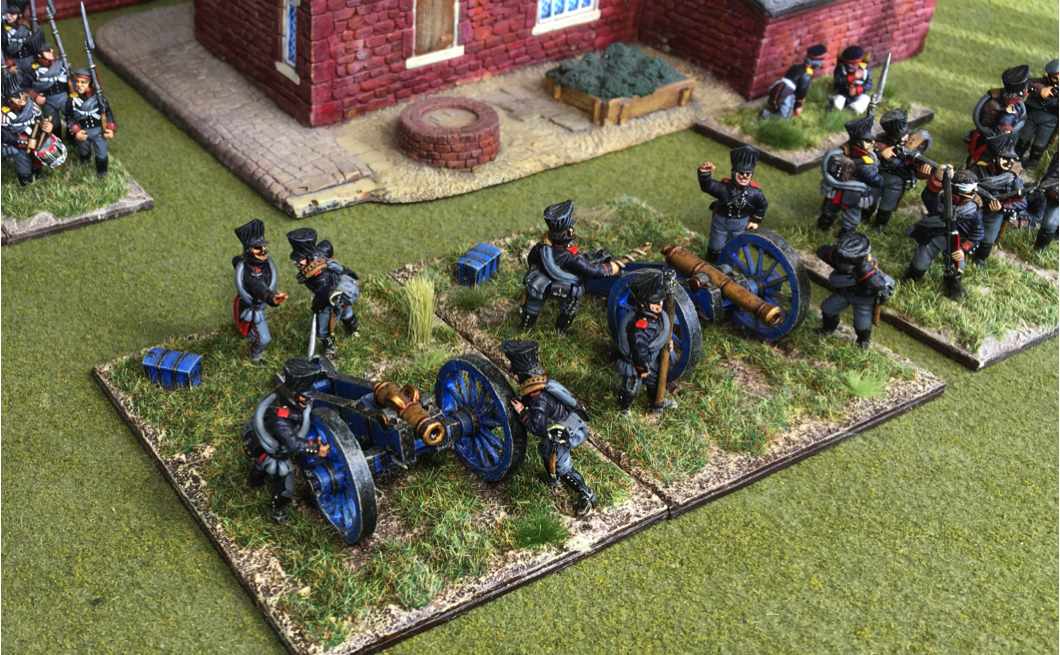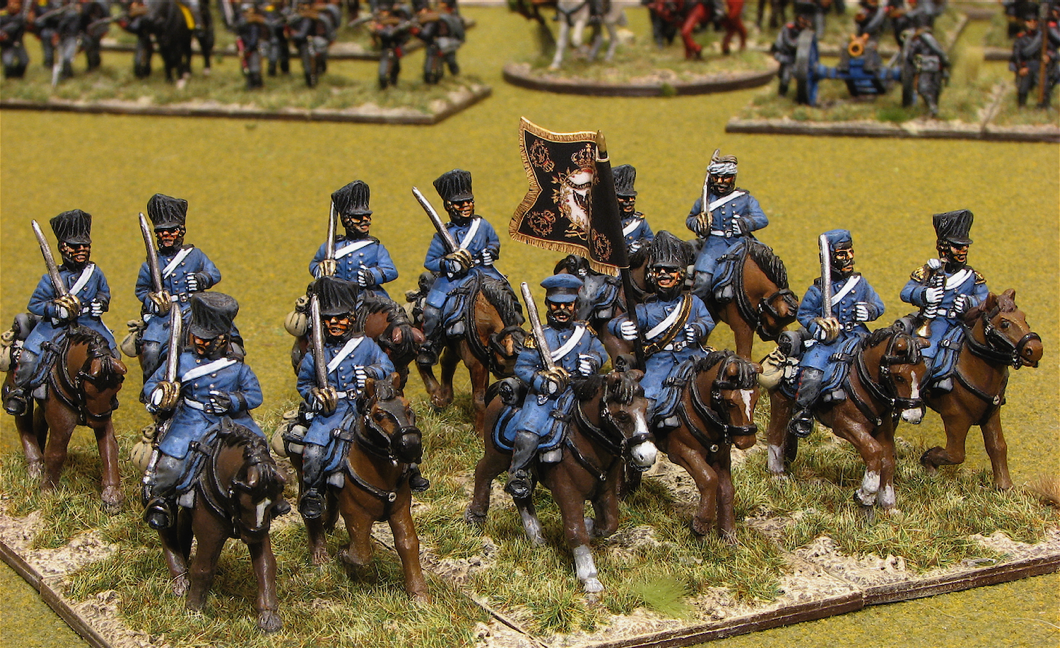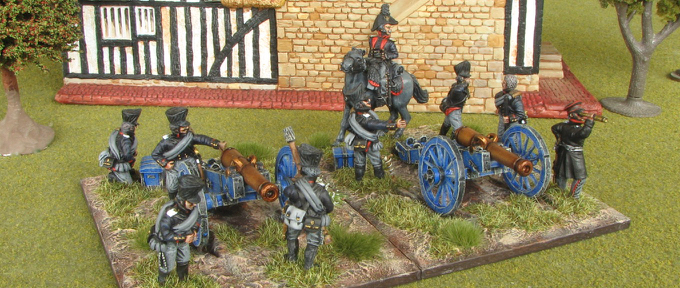
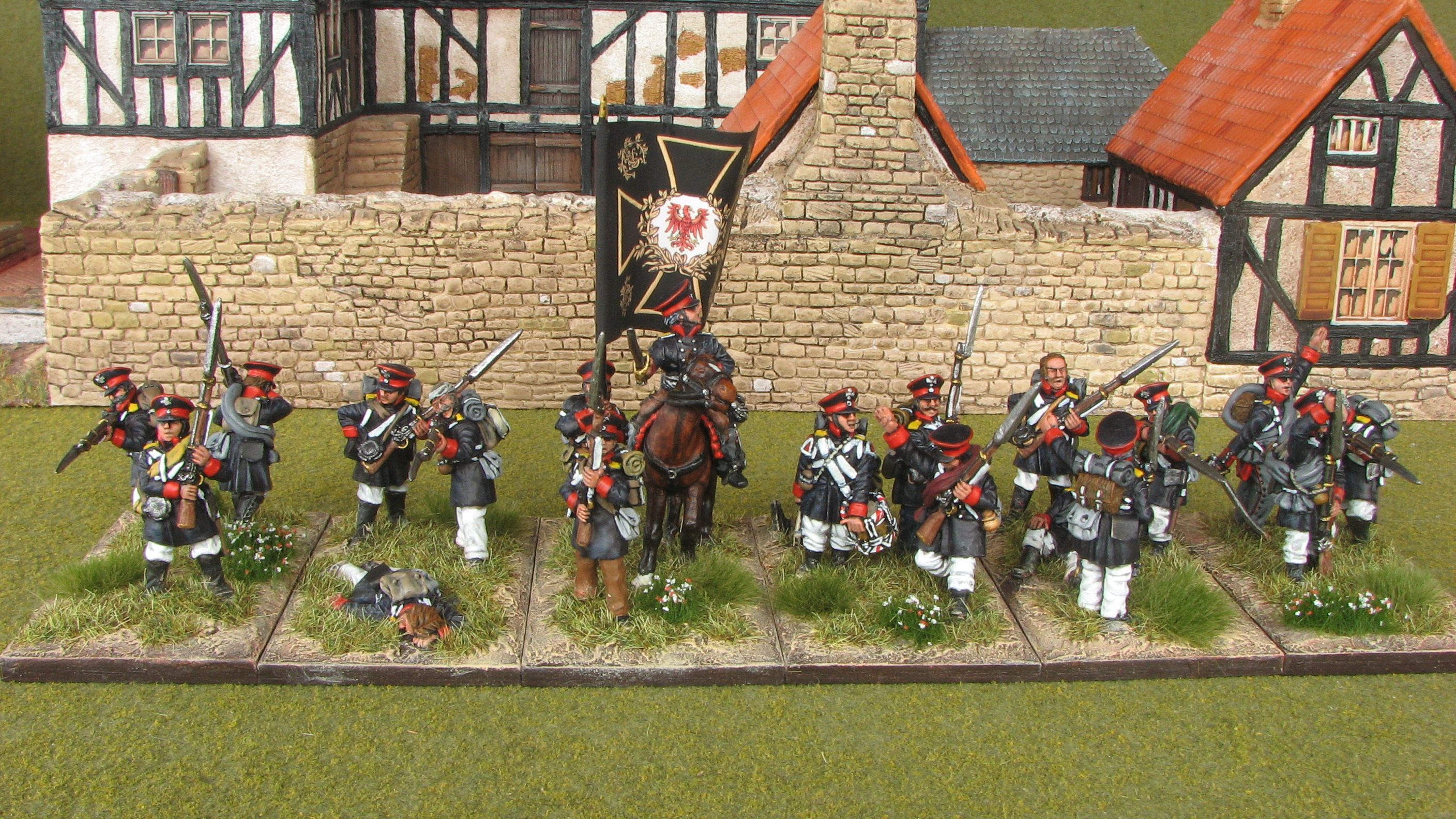
Napoleonic Prussians
The first and favourite Napoleonic army for von Peter himself. The aim is the recreation of Generalmajor Hessen-Homburg's 3rd Brigade of Generallieutenant Bulow’s 3rd Corps from the 1813 campaign ... with the addition of some Corps assets.
The rapid expansion of a vengeful Royal Prussian Army in 1813 probably came as quite an unwanted surprise to the French. The reserve units and the landwehr provided much of that expansion. The Krumper system whereby the Prussian Army rotated recruits through the army provided some of the expanded army with some level of training though the affects of this should not be over stated. For many recently inducted into the army it was a classic case of "you're in the army now" with accelerated on the job training. While this doesn't sound ideal the destruction wrought on many armies in the 1812 Russian campaign and the subsequent re-raising of those armies meant that many units in many armies were in exactly the same position.
Except for several medical figures the collection is exclusively from Calpe Miniatures. If there is a more comprehensive range out there then von Peter himself has yet to see it. The premier 28mm Napoleonic Prussian range in this authors opinion ... but von Peter himself is totally smitten, biased and a self confessed Calpe zealot! He loves his Calpe Miniatures.
A quick word on the "Prussian Blue" used on the regular infantry, the landwehr, the artillery crew etc. Some people like to "scale" their colour selection. In short the theory says that the smaller the figure the lighter your paint selection should be. All very fine but to the eyes of von Peter himself Prussian Blue is a dark blue and any lightening of that blue results in something other than Prussian Blue. So a darker blue is applied than some use but von Peter himself is happy with the result.
von Peter’s painting with the exception of some of the horses and the artillery gun barrels by Craig W. Flags from GMB Designs.
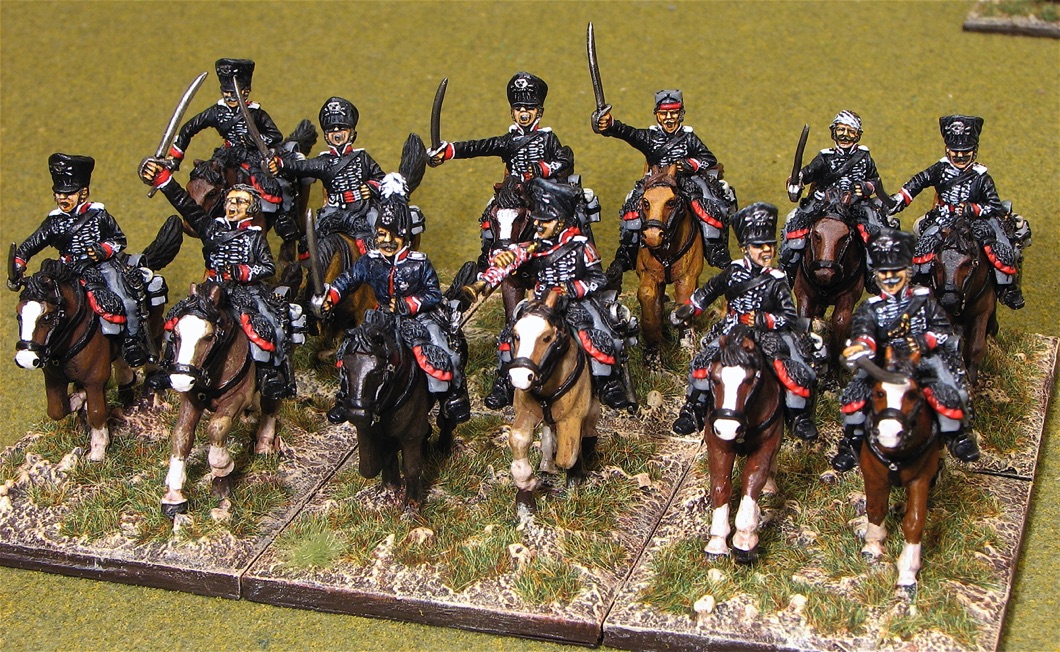
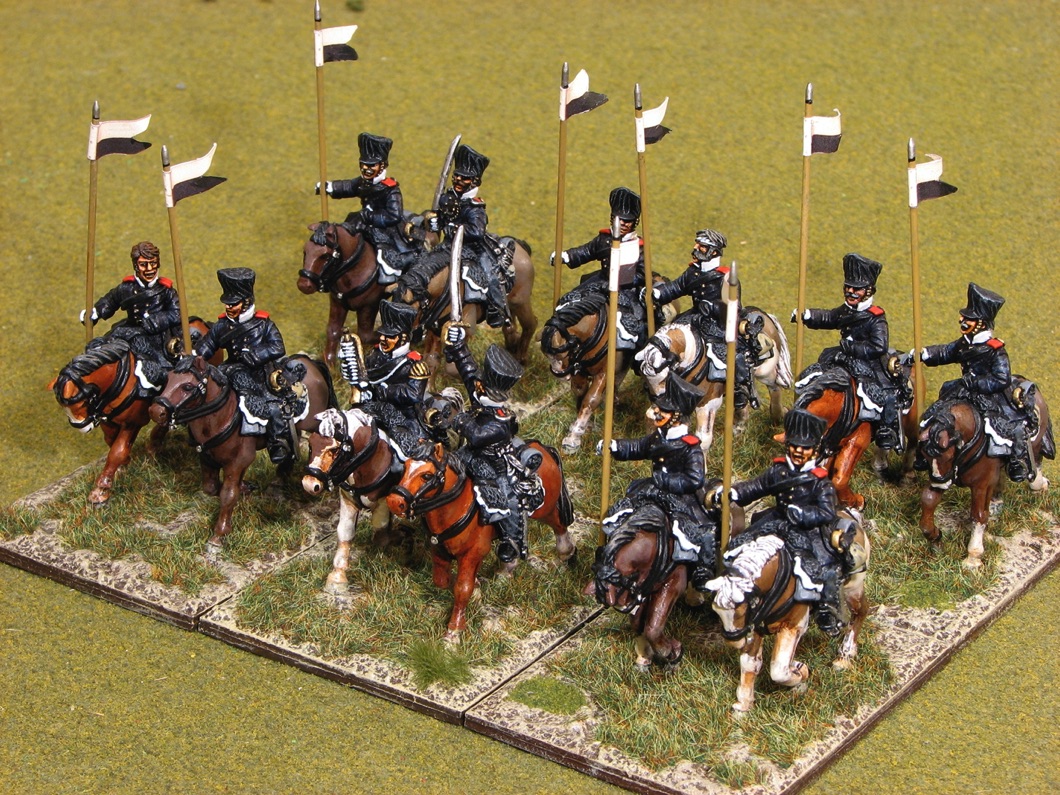

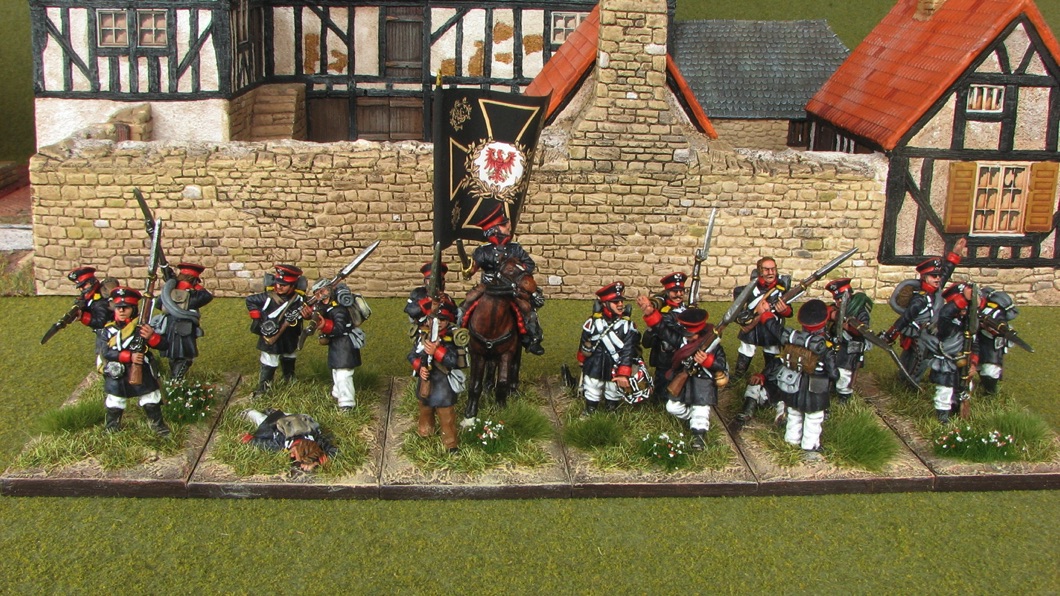
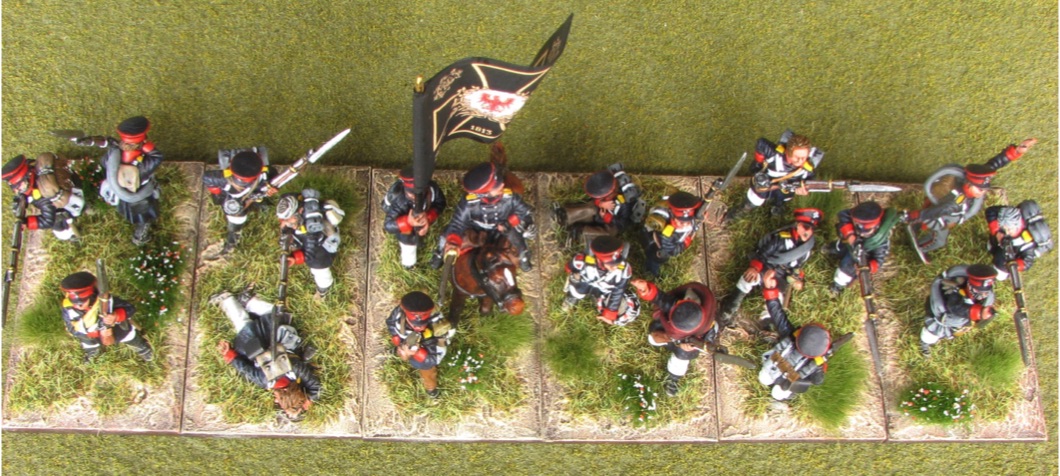

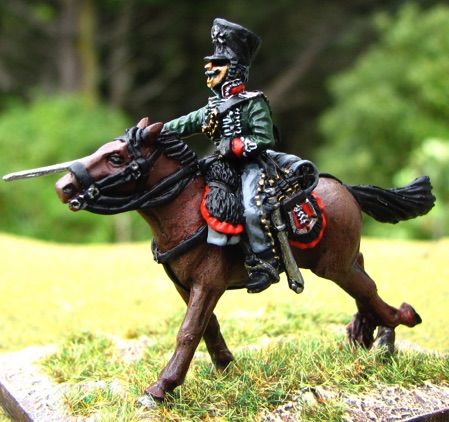
3rd Brigade
Prussian Brigades of 1813 were quite big beasts - more like a French Division. The 3rd Prussian Brigade comprised ...
●︎ 2nd East Prussian Grenadier Battalion *
● 4th (3rd East Prussian) Infantry Regiment *
● 4th Reserve Infantry Regiment
● 4th East Prussian Landwehr Infantry Regiment
● 6 pdr Foot Battery Nr. 6: Kapitain von Glasnapp
● 1st Leib Hussar Regiment *
* these units had Freiwillige (Volunteer) Jäger attached.
Command
The description for the Calpe Command Pack PC1 goes something like this ...
4th Reserve Infantry Regiment
There were three battalions in the regiment. So far von Peter himself has only managed to raise the first battalion. In his defence while they may present a fine sight with all that lace and piping that same lace and piping needs to be painted which takes time. On the plus side the metal has been procured for the remaining two battalions ... it's just that that metal has no choice but to wait patiently in the unpigmented figure pile. Oh, and there has been a little cheating involved with the purchasing of the third (fusilier) battalion. What exactly "cheating" means will be withheld in all likelihood for quite a while until that battalion is painted.
The 4th Reserve Infantry Regiment received their uniforms from the British. These particular uniforms had been manufactured in the Portugese style. As was the case with the Prussian Reserve Infantry while the men wear their reservist uniform the cadre staff - officers and nco's - retained their regular regiment uniform of the unit they were seconded from.
The Reserve Infantry Regiments should in all probability not have flags but where's the fun in that? It was the particular pleasure of von Peter himself to issue a flag to the current battalion of the regiment. The flag chosen was one of the spares from the regiment's parent formation - the 4th Infantry Regiment (3rd East Prussian).
The following picture of the first battalion is one of von Peter's more widely seen photographs. It was the heading photo on von Peter's original blog and was snapped on the 2nd October 2006.
4th East Prussian Landwehr Infantry Regiment
Originally formed of four battalions - the number shrinks over the course of the campaign to three by the time of the Battle of Leipzig - the 4th East Prussian Landwehr Infantry Regiment no doubt learned much of its trade the hard way on the job.
von Peter himself has given them the red provincial colour of the East Prussian landwehr on collars and cuffs. The shoulder straps of each battalion have been painted in the appropriate seniority colour ...
1st battalion - white
2nd battalion - red
3rd battalion - yellow
4th battalion - light blue ... or will do when it is painted.
Having painted three of the planned four battalions von Peter himself decided to look up the regiment in Dr. Stephen Summerfield’s “Prussian Napoleonic Landwehr Infantry and Cavalry 1813-1815: Landsturm, Volunteer Cavalry and StreifKorps”. As with the rest of the series the book is chocked full of information. It was not in the possession of von Peter himself when he painted battalions one & two or started painting the battalion three which is important as it forms some sort of defence for the coming statement. The book states that the 4th East Prussian Landwehr Infantry Regiment had grey trousers, black belts, a stripe in the facing colour on the sleeves rather than the cuffs fully coloured and all battalions with light blue shoulder straps for the forth regiment in the province!. Oops. Too late. We’re moving on! Perhaps the 4th battalion will get it right. Some general variation in uniform colours has been included as befits a regiment suffering from supply difficulties.
Calpe Miniatures have had two generations of landwehr figures. The first generation may even have been the first figures Calpe released. The second generation are the current figures. Offhand one of the obvious changes between the generations was the shape of the schirmutze (hat).
The Landwehr battalions were officially banned from having flags but the message does not seem to have made it through to the battalions of von Peter himself. Especially as GMB Designs have some excellent designs to choose from.
The 1/4th East Prussian Landwehr Infantry Regiment is completely sourced from the from the first generation "Route March" figures from Calpe Miniatures. They proudly carry two flags with the red hereditary Prussian eagles.
The 2/4th East Prussian Landwehr Infantry Regiment is also from the "Route March" range but the figures are mostly sourced from the second generation range. The grey uniforms were the result of some neurons having an off day. They were pleasing to paint and look ok but historically are a bit suspect!
The 3/4th East Prussian Landwehr Infantry Regiment is posed as a shot up firing line. The idea for this battalion came about due to Calpe's extended landwehr range including several casualty figures. In fact so many different casualty figures that not all of them could be utilised in the battalion! The down side of modelling a landwehr battalion as a shot up firing line is that the landwehr battalions are probably the least likely to be formed in a line during a game. One would think that column would be a much more comfortable formation for a unit learning its trade. Regardless, once the idea for the battalion had been thought it just wouldn't go away.
The Cape Miniature’s figures were not the only inspiration for the 3rd battalion. Richard Knoetel’s drawing of a mixed – regulars and landwehr – firing line around the churchyard at Grossbeeren, August 1813 (below) also played its part. Apparently the drawing shows all the steps of loading and firing a musket so have a good look and be educated.
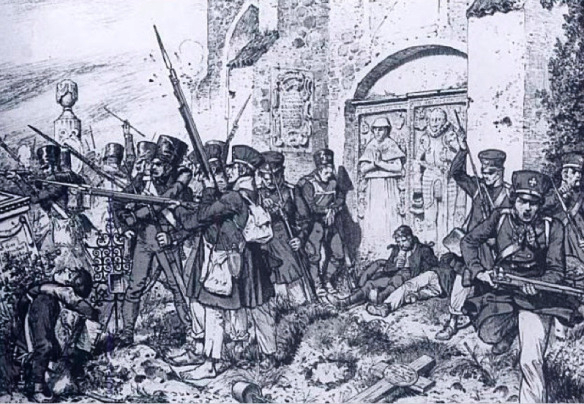
The 4/4th East Prussian Landwehr Infantry Regiment is still in the very initial planning stages. That is to say that the figures have not yet even made it into the unpigmented figure pile. The aspect of the battalion is not yet chosen but is most likely to be either Advancing or Charging with the latter the current favourite.
1st Leib Hussar Regiment
Every Prussian Brigade in 1813 had a cavalry regiment included. For the 3rd Brigade this meant the 1st Leib Hussar Regiment and their 195 freiwillige (volunteer) jager. That the 1st Leib Hussars were part of the brigade was one of the reasons von Peter himself chose to model the 3rd Brigade. How can you go wrong with the famous deaths head hussars dressed in black with white and red highlights?
All that traditional hussar and other fine detailing - braiding, piping etc - was thankfully a relative doddle to paint as it was all sculpted on the figures. And the quality of the casting meant that it was still there to take advantage of! All that was needed was to take ones time to pick it out. Top marks and waves of relief to Mr Calpe Miniatures. Horses painted by Craig Watterson.
To date the lone representative of the Freiwillige (Volunteer) Jäger of the 1st Leib Hussars is an officer. He is often used as a brigade commander as von Peter himself is short of these for his gaming. With a view to the future he is based on a standard (for von Peter himself anyway) cavalry base. When a second Freiwillige Jäger is painted he will be added to this base. Such organisational foresight and brilliance!
See the Freiwillige (Volunteer) Jägers section above for background details on the Freiwillige Jäger.
4th (3rd East Prussian) Infantry Regiment
The Prussian regular infantry regiments had a dual numbering / naming convention. First there was the ordinal number of the regiment that sequenced all the infantry regiments in the army. Then there was the numbering of the regiment within the province of their name. So this regiment is numbered fourth amongst all the infantry regiments in the Royal Prussian Army. Additionally it is the third heavy infantry regiment of the East Prussian regiments. See? Easy!
Like all of all the infantry regiments it consists of three and a half battalions. The half battalion is made up of the grenadiers. These are detached in wartime to join with the grenadiers from another regiment to form a grenadier battalion. In this case they amalgamate with the grenadiers from the 5th (4th East Prussian) Infantry Regiment to form the 2nd East Prussian Grenadier battalion which happily is also incorporated in the 3rd Brigade. Sadly the figures for it are yet to be pigmented.
The remaining three battalions are made up of two battalions of musketeers and a battalion of fusiliers.
The 1/4th (3rd East Prussian) Infantry Regiment - a musketeer battalion - was either the first or second Calpe unit painted by von Peter himself. And that folks makes it officially a long time ago. The battalion has been reflagged once and its basing upgraded at least twice. And it is showing some signs of fatigue. Darn! Some paint touch ups required.
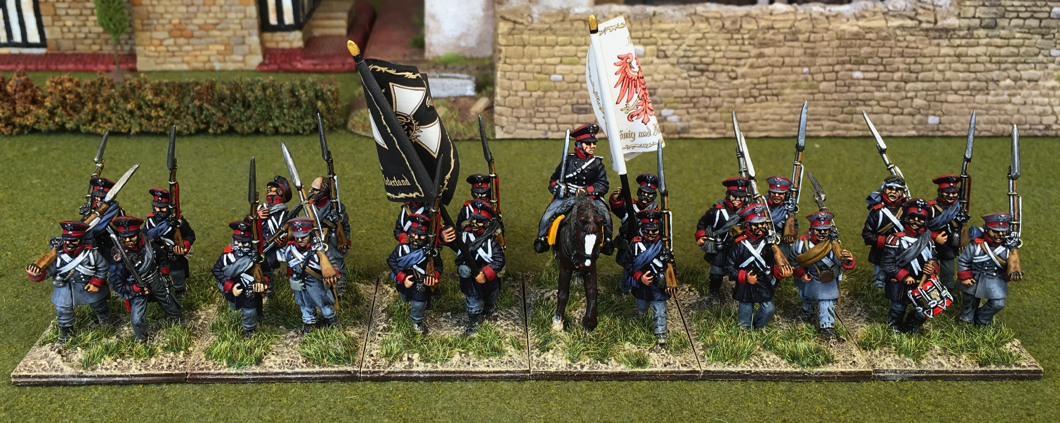
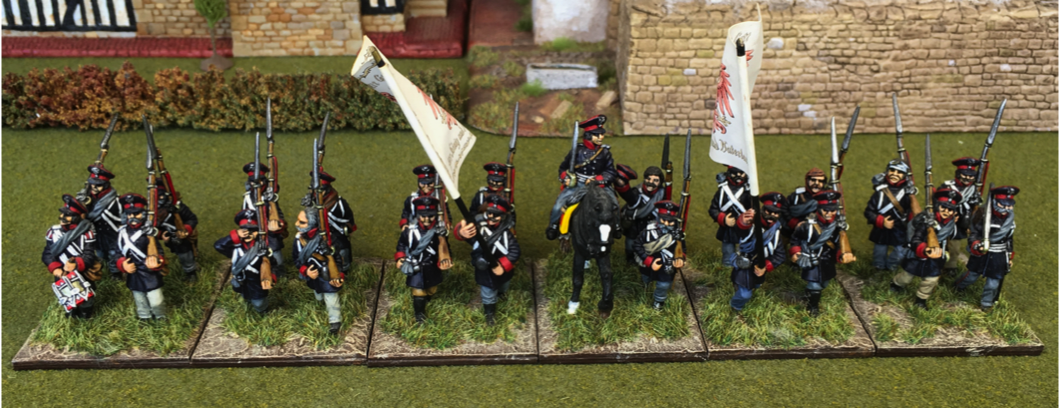
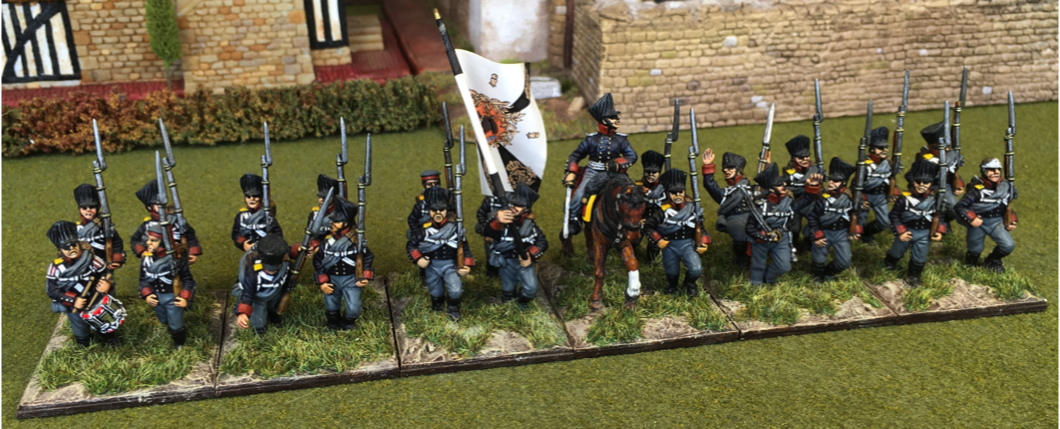
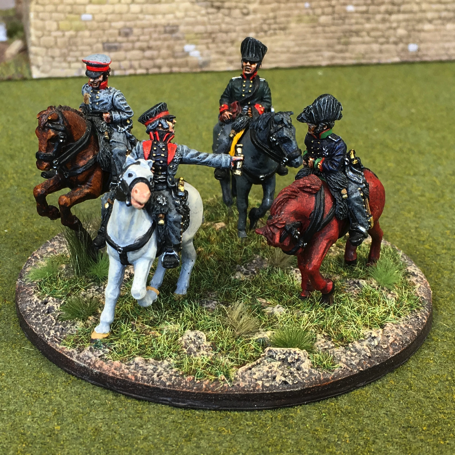
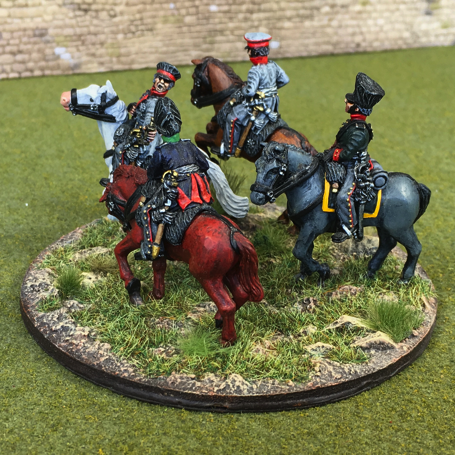
The brigade commander is watching the attack through his small telescope. He likes this telescope as it fits into his coat pocket when not in use. The three battalions of his Landwehr regiment took the village this morning but were thrown out in disarray by a concerted Saxon counterattack. To their credit the Landwehr infantry regrouped on reaching his lines and are now supporting his reserve infantry battalions as they try to force the stubborn Saxon infantry out of the village. As he watches he suddenly sees the Saxons streaming out of the other end of the village, running towards the cover of the woods. He snaps his telescope shut and whirls round in the saddle to get his brigade cavalry to intercept the fleeing Saxons. As he turns he pulls on the reins causing his horse to shy back. The sudden movement startles the staff officer’s horse and it rears up. The staff officer manages to keep his seat and brings the animal under control. Meanwhile, the ADC has spurred his horse towards the General and leans forward in his saddle so that he can hear the orders over the noise of the continuing battle. At a discrete distance, the Feldjaeger officer watches and prepares his leather satchel for the stream of orders which he knows will now follow.
The uniforms (and telescope) details are taken from a Brauerbogen plate.
The general wears his Kleine uniform with the unbuttoned uberrock over the top and a covered cap as headgear. The General Staff officer is in uberrock and cap with his notebook tucked into the front of his uberrock. The ADC wears his kollet and bicorn in a weatherproof cover. The feldjaeger officer wears the standard uniform (note the waist sash). soon!
von Peter himself painted this set in a hurry and though it looks fine on the table top the figures really deserve better.
Brigade: Oberst Treskow
Oberst Treskow leads a brigade of three dragoon regiments. More details to come.
Brandenburg Dragoons
This regiment was the first of the three dragoon regiments to be painted purely because of their black facings. The unit was needed quickly - probably for some convention game - and the thinking was something along the lines of "what could be quicker to paint than black facings". The horses were painted by Craig Watterson.
Brigade: Oberst von Malzahn
The good Oberst von Mazahn leads a brigade of three landwehr cavalry regiments. More details to be added.
2nd Pomeranian Landwehr Cavalry Regiment
Fairly much a regulation uniform for the men of the 2nd Pomeranian Landwehr Cavalry as they are presented here. Another option would have been a grey Litewka - jacket. Annoyingly they had what was to become the standard Prussian white over black lance pennon whereas other landwehr regiments had much more colourful versions in 1813. The White collars denote the regiment as being from Pomerania while the red shoulder straps denote it as the second cavalry regiment from that province. Horses painted by Craig Watterson.
3rd Corps Reserve Artillery: Oberstleutnant Holtzendorf
The reserve artillery of the Prussian 3rd Army Corps was under the command of Oberstleutnent Holtezendorf. A few more details to come.
12pdr Foot Battery Nr. 4: Kapt Meyer
Prussian 12 pounder Battery Nr.4 was chosen because it was part of the Artillery Reserve in Generallieutenant Bülow’s Prussian 3rd Army Corps in 1813 – the same corps as the 3rd Brigade which von Peter himself is modelling. Administratively 12 pdr battery Nr.4 was part of the Prussian Artillery Brigade and as such wore white shoulder straps in 1813.
The mounted figure is the Regimental officer wearing bicorn and open Uberock from the Prussian Line Uhlans Advancing range. The idea is that the uhlan officer has just arrived on the scene with an urgent message for the battery commander who is currently concentrating on what is to be seen through his telescope. The uhlan officer and several of the gun crew are trying to gain the battery commander’s attention but sadly this gentleman has been around 12 pounder guns too long with the result that he is a little hard of hearing! The dear reader may see the scene a little differently in which case all power to their imagination.
The Fusilier battalion 4th (3rd East Prussian) Infantry Regiment provide a complete battalion of light infantry to the regiment. Not that the regiment was short of light infantry as the third rank of the musketeer battalions were trained light infantrymen and in 1813 there were also the attached freiwillige (volunteer) jager of which more shortly.
This battalion is posed as a firing line which is the standard for Napoleonic light battalions of von Peter himself. It was painted shortly after the first battalion of the regiment so it has been soldiering on for quite a while. It's reward is to have had its basing upgrading on several occasions. What more could it desire?!
Freiwillige (Volunteer) Jägers
An edict of 3 February 1813 called for the creation of Freiwillige (Volunteer) Jäger attachments for each (regular?) infantry battalion and cavalry regiment. The volunteers were to be aged between 17 and 24 years old - this criteria removed on February 10th - and they were to serve for the duration of the war without pay. Additionally they were to provide their own arms and uniform but possibly only around a third of the volunteers could afford to do so so the outstanding costs were provided by provinces or individual donations. Initial training was provided by the regiment they were attached to. On 19 March 1813 it was further decreed that the Freiwillige Jäger attachments were to be considered as a source of future officers and that they were to be trained as such and their strength was not to be unnecessarily frittered away.
The size of the various attachments varied. On the 10 August 1813 the Freiwillige Jäger detachments within the 3rd Brigade were ...
●︎ 203 Jäger with the 2nd East Prussian Grenadier Battalion
● 197 Jäger with the 1/4th (3rd East Prussian) Infantry Regiment
● 157 Jäger with the Fus/4th (3rd East Prussian) Infantry Regiment
● 195 Jäger with the 1st Leib Hussar Regiment.
von Peter himself has created a composite Freiwillige Jäger unit to cover off the attachments to the battalions of 3rd Brigade. The unit can be played as one or the stands can be split up as required by different gaming systems. The bases have been cunningly designed / choreographed to mimic the practice whereby the jägers worked as pairs with one of the two jägers always having a loaded rifle. Therefore no base has both figures firing or both loading.
The Freiwillige Jäger attached to the Leib Hussars will be covered with the Leib Hussars below.

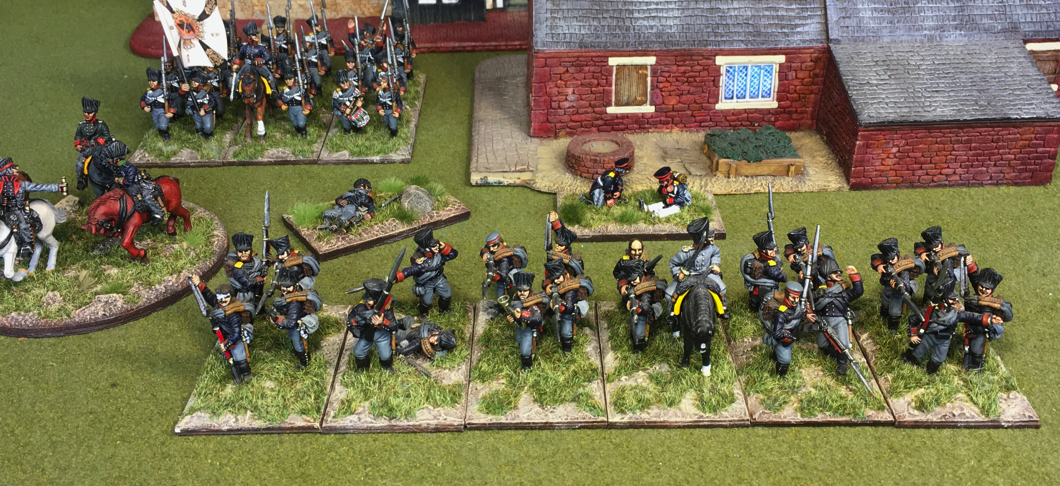
6 pdr Foot Battery Nr. 6: Kapitain von Glasnapp
All of the 1813 Prussian Brigades had a 6 pounder foot battery attached for fire support. The rest of the foot artillery was held in Corps reserves - remembering that there was no Prussian Army field force in 1813 as its Corps were spread across several Allied Armies.
For the 3rd Brigade this was the 6 pounder foot battery Nr. 6: Kapitain Glasnapp. Being part of the Brandenburg Artillery Brigade the gunners have red shoulder straps.
Calpe Miniatures provide 21 Prussian Foot Artillery figures plus a mounted officer and a set of four marching gunners. So plenty of choice is available. The website provides suggestions as to which figures fit best with either a firing, loading or aiming crews.
Initially the guns came with the thick wheels as seen below. Redesigned thinner wheels soon replaced these and von Peter himself has replacement thinner wheels for the battery but actually replacing them does not seem to be imminent as it would require breaking the guns off their bases and then breaking the wheels off the cannons.
